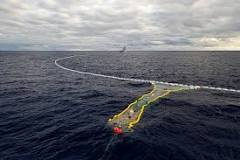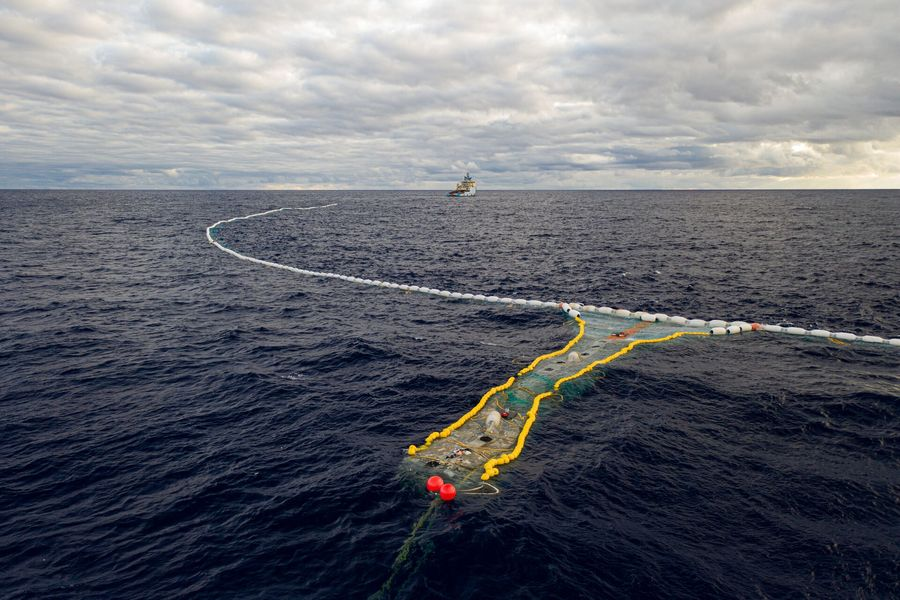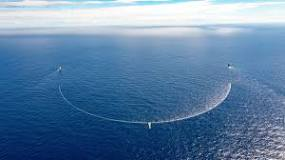OCEAN CLEAN UP TECH:
Ocean cleanup technologies use a variety of methods to remove plastic from the ocean and rivers. These technologies include floating barriers, river booms, boats, drones, and robots.
Floating barriers
- The Ocean Cleanup’s ocean system uses a funnel-shaped floating barrier that’s towed by two ships.
- In 2019, a 600-meter-long crescent-shaped boom was used to scoop up plastic from the Great Pacific Garbage Patch.
River booms
- The Ocean Cleanup’s Interceptor river solutions are deployed around the world to stop plastic from flowing into the ocean.
Drones and robots
- Drones equipped with cameras and sensors are used to monitor and survey plastic pollution in the ocean.
- Autonomous Underwater Vehicles (AUVs) are used to collect data on underwater plastic pollution.
Other technologies detection aids, waterway litter traps, sand filters, air barriers, and surface skimmers and vacuums.
The Ocean Cleanup is a non-profit organization that was founded in 2013 by Dutch inventor Boyan Slat. Their goal is to reduce floating ocean plastic by 90% by 2040.
KEY TECHNOLOGIES:
Ocean cleanup technologies include barriers, robots, and satellites. These technologies are used to prevent plastic from entering the ocean and to clean up plastic that has already accumulated.
Barriers
- The Great Bubble Barrier: Uses air bubbles to redirect plastic waste into collection systems
- Interceptor: A solar-powered barrier that catches trash flowing into rivers
- U-shaped barrier: Guides plastic into a retention zone
Robots
- Clearbot: A swarm of AI-powered robots that detect and collect trash from water
Satellites
- Satellite imagery: Combined with Earth-based sensors and measurements to provide data to scientists
Other technologies
- Biofences: A technology used to prevent ocean plastic pollution
- Drone surveillance: Used to monitor the ocean
- Autonomous underwater vehicles (AUVs): Used to clean up the ocean
- Plastic-eating enzymes: Used to break down plastic
Other ways to help
- Conserve water
- Reduce pollutants
- Reduce waste
- Shop wisely
- Reduce vehicle pollution
- Use less energy
- Fish responsibly
- Practice safe boating

PROS AND CONS OF OCEAN CLEAN UP TECH:
Ocean cleanup technology has potential pros like removing large plastic debris from the ocean, raising awareness about pollution, and gathering data on plastic distribution; however, significant cons include potential harm to marine life through bycatch, limited effectiveness against microplastics, high cost, and the risk of disincentivizing efforts to reduce plastic production at the source, potentially leading to a “false solution” perception.
Pros:
- Reduces large plastic debris: Ocean cleanup technology can actively remove large pieces of plastic from the ocean, mitigating the immediate threat of entanglement and ingestion by marine animals.
- Data collection: Deployment of these systems can provide valuable data on the distribution and concentration of plastic pollution in the ocean, aiding in research and policy development.
- Raises awareness: High-profile ocean cleanup initiatives can raise public awareness about plastic pollution, promoting behavioral changes and supporting efforts to reduce plastic waste.
- Potential for innovation: Developing new and improved cleanup technologies can lead to more efficient and targeted approaches to tackling plastic pollution.
Cons:
- Bycatch concerns: Ocean cleanup systems can unintentionally capture marine life, including plankton and fish, causing harm to ecosystems.
- Microplastic limitations: Most current technologies struggle to effectively remove microplastics, which are a significant portion of ocean plastic pollution.
- High cost: Implementing and maintaining ocean cleanup operations can be very expensive, limiting scalability.
- False solution perception: Public perception may mistakenly believe that ocean cleanup technology alone can solve the plastic pollution problem, discouraging efforts to reduce plastic consumption at the source.
- Environmental disruption: Depending on the design and location, cleanup operations could disrupt delicate marine ecosystems.
- Limited reach: Ocean currents and the vastness of the ocean can make it difficult for cleanup systems to reach all areas of plastic pollution.
Key points to consider:
- Focus on prevention: While ocean cleanup technology can play a role, the most effective strategy to address plastic pollution is to prioritize prevention through reducing plastic production and improving waste management practices.
- Careful design and monitoring: Ocean cleanup technologies need to be carefully designed and monitored to minimize bycatch and other environmental impacts.
- Transparency and communication: Open communication about the limitations and potential drawbacks of ocean cleanup technology is crucial to manage public expectations.
USES OF OCEAN CLEAN JUP TECH:
Ocean cleanup technologies are used to remove plastic and other debris from the ocean and rivers. The goal is to reduce plastic pollution, protect marine life, and improve the health of marine ecosystems.
How ocean cleanup technologies are used
- Intercepting plastic in rivers The Ocean Cleanup’s “Interceptor” solutions use conveyor belts to remove plastic from rivers before it reaches the ocean.
- Collecting plastic in the ocean The Ocean Cleanup Array uses floating barriers to concentrate plastic pollution into a central collection point.
- Collecting floating debris in ports and marinas Seabins use pumps to draw water into a removable filter bag that captures floating debris.
- Tracking marine pollution Citizen scientists use trawls to collect floating debris from the water’s surface.
Benefits of ocean cleanup technologies
- Reduce plastic pollution: This can help protect marine life and improve ecosystem health.
- Promote innovation: The success of ocean cleanup technologies can inspire further research and development.
- Provide a platform for scientific research: Ocean cleanup technologies can provide data on pollution levels and sources.
Challenges of ocean cleanup technologies damage to ecosystems, low cost-efficiency, and lack of proper disposal opportunities.

HOW IT WORKS:
Ocean cleanup technology, primarily developed by “The Ocean Cleanup” organization, uses a large, U-shaped floating barrier that passively collects plastic debris by drifting with ocean currents, essentially acting like a giant net to concentrate plastic within a “retention zone” where it can be periodically collected and removed by support vessels, allowing for efficient cleanup within plastic-dense areas of the ocean, like the Great Pacific Garbage Patch; this system relies on computational modeling to identify plastic hotspots and utilizes sensors and AI to optimize its position and operation.
Key points about ocean cleanup technology:
- Passive collection: The barrier is designed to move slowly with the ocean currents, allowing plastic to naturally flow into the retention zone within the U-shape.
- Targeting hotspots: Using computer models, the system is positioned in areas where plastic is most concentrated, maximizing cleanup efficiency.
- Retention zone: The central area of the U-shaped barrier where plastic accumulates, allowing for easy collection.
- Vessel support: Dedicated vessels are used to periodically collect the plastic from the retention zone and transport it to shore for recycling.
- Sensors and AI: Advanced technology like sensors monitor ocean conditions and AI algorithms help optimize the system’s movement and decision-making.

